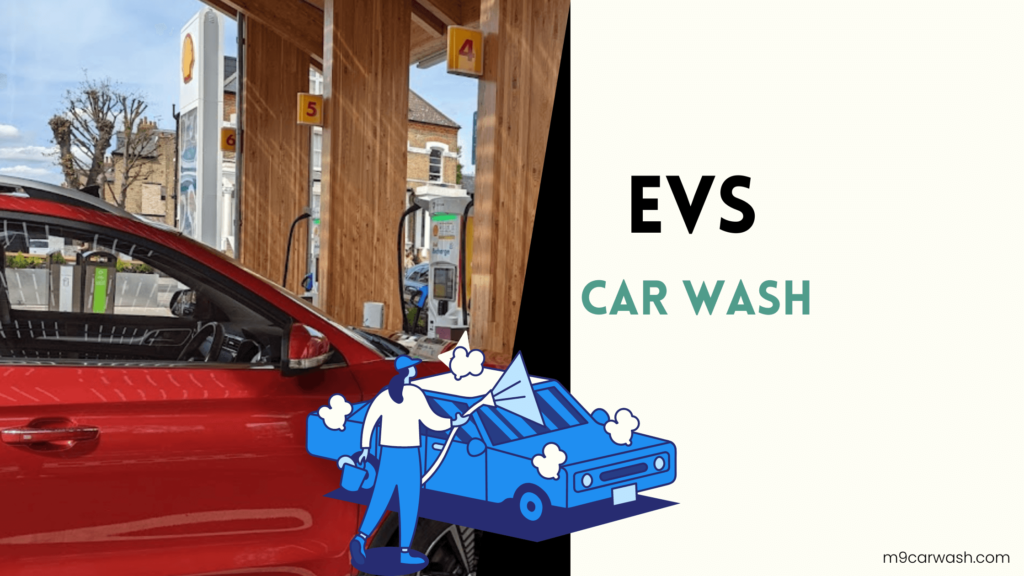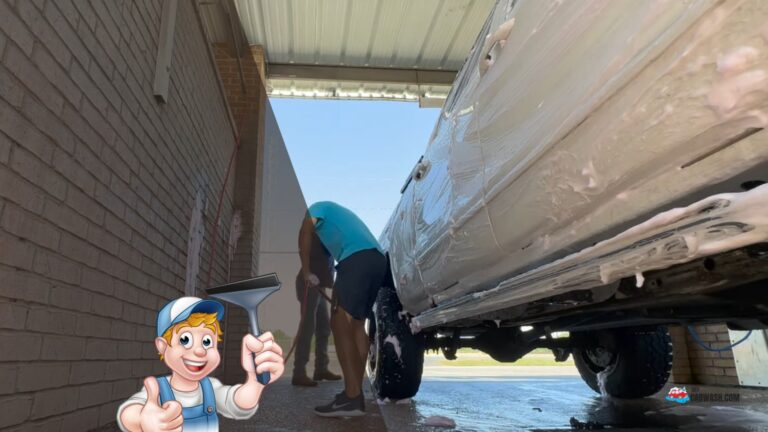Washing an electric vehicle (EV) is straightforward, but there are some key points to consider to protect your car’s components, especially near the charging port and electrical components.
Most EVs are designed to be resistant, handling normal water exposure.

Electric Vehicles and Water
EVs are designed to withstand water exposure.
Most of the parts, especially the electric system and battery, are sealed to prevent water intrusion.
This means that washing your EV is safe, whether you’re using a manual wash or an automatic car wash.
Water and electricity don’t mix, but modern electric cars are built with safety in mind.
The charging port is designed to resist water damage, so you don’t need to worry about it during a wash.
I have washed my fair share of EVs in my Car Wash and they all went fine. Just make sure to close all windows and doors properly before starting.
Preparing Your EV for Car Wash
Before taking your EV through a car wash, a few simple preparations can make a difference.
First, I recommend putting the car in neutral. This prevents the wheels from locking and helps it move smoothly through the wash tunnel.
Next, check your wipers. Ensure they’re not stuck to the windshield to avoid any damage during the wash. If you’re using an automatic car wash, it’s a good idea to disable any automated systems that could interact with the car’s settings.
Lastly, consider a pre-wash using a gentle cleaning product.
This removes dirt and grime, making the wash more effective. You can also apply a coat of wax after washing can help protect your vehicle’s paint.
Automatic Car Washes
Automatic car washes can be a quick and easy option.
These usually include tunnel washes and rollover systems. In a tunnel wash, the car moves through a series of brushes and jets while being automatically cleaned. Most EVs require the vehicle to be in neutral during this process to prevent any issues with locking wheels.
It’s also essential to disable any electrical components that may interfere with the washing process. This can include using the vehicle’s settings to turn off washing mode.
Many modern EVs are designed to handle this environment, making it safe to use automatic washes. Just remember to choose a wash with soft materials to protect the finish.
Manual Wash for EVs
Hand washing provides the most control over the cleaning process.
Using a bucket, sponge, and car wash soap allows for thorough cleaning while being gentle on surfaces.
I find that using jet wash systems for rinsing can effectively remove dirt without damaging the car.
It’s crucial to dry the vehicle after washing to prevent water spots, especially around electrical components. A microfiber towel works well for this.
Regular maintenance is also key. Check the undercarriage and electric components after washes, especially after going through automatic washes.
How to Avoid Water Damage for EVs during Car Wash?
Before entering a car wash, ensure the seals around doors and windows are intact. This prevents water from entering the interior, which can lead to issues. At the car wash, avoid high-pressure sprays directly at electrical components or charging ports.
I recommend opting for touch-free car washes.
These systems use water and soap without brushes, reducing the chances of scratches and keeping vital areas dry.
Also, avoid washing your car during heavy rain. Flood levels can overheat the battery pack.
Post-Wash Checks and Care
- Inspect the charging port. Make sure it’s completely dry before plugging in to charge. Moisture can damage the electrical system if not addressed.
- Check the exterior for any remaining water spots. I like to use a microfiber cloth to dry any spots around the seals. This helps prevent mold or mildew growth. It’s also a good habit to inspect the battery area for any leaks or unexpected damage.
- Apply a protective wax or sealant after washing. This not only enhances shine but can also give an extra layer of protection against the elements.
Precautions to take when washing an electric vehicle
Turn off your electric vehicle before washing it.
This helps prevent any electronic components from getting damaged.
Make sure that any charging ports are closed and protected from water. Avoid using high-pressure water directly on sensitive areas.
Is it safe for all-electric vehicles to go through automatic car washes?
Yes, most electric vehicles are designed to handle water exposure.
Manufacturers ensure that electric cars meet safety standards, which include being water-resistant.
But like I always said, it’s always good to check your owner’s manual for any specific recommendations.
Are touchless car washes Allowed for electric cars?
Touchless car washes are safe for electric vehicles.
These car washes use high-pressure water and soap without physical brushes, reducing the risk of scratches.
Before going through the car wash, check that the vehicle is cleaned of any loose dirt or debris and the charging port is securely closed.
Are there specific car wash modes for electric vehicles like the Chevy Bolt?
Some car washes may have special modes for electric cars, but it’s not common.
The Chevy Bolt and similar models can typically go through standard car wash systems.
It’s best to consult the owner’s manual for any specific instructions related to car washing.
The difference Between Washing an electric and washing a Traditional Gasoline Vehicle
Washing an electric vehicle is largely similar to washing a gasoline car.
The main difference lies in checking the charging ports and ensuring electronic components aren’t exposed to water.
- Sensors and Cameras: Electric cars often have more sensors for autonomous features, requiring gentle handling.
- Charging Port: Ensure the charging port is securely closed and avoid directing high-pressure water at it.
- No Exhaust: No need to clean exhaust pipes in electric cars.
Other than these, the process remains largely the same.






